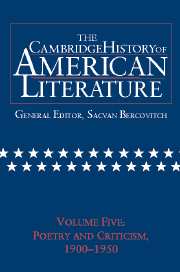Book contents
- Frontmatter
- Introduction
- MODERNIST LYRIC IN THE CULTURE OF CAPITAL
- POETRY IN THE MACHINE AGE
- Prologue
- 1 Gertrude Stein: the poet as master of repetition
- 2 William Carlos Williams: in search of a western dialect
- 3 H. D.: a poet between worlds
- 4 Marianne Moore: a voracity of contemplation
- 5 Hart Crane: tortured with history
- 6 Langston Hughes: the color of modernism
- LITERARY CRITICISM
- Chronology 1910–1950
- Bibliography
- Index
6 - Langston Hughes: the color of modernism
from POETRY IN THE MACHINE AGE
Published online by Cambridge University Press: 28 March 2008
- Frontmatter
- Introduction
- MODERNIST LYRIC IN THE CULTURE OF CAPITAL
- POETRY IN THE MACHINE AGE
- Prologue
- 1 Gertrude Stein: the poet as master of repetition
- 2 William Carlos Williams: in search of a western dialect
- 3 H. D.: a poet between worlds
- 4 Marianne Moore: a voracity of contemplation
- 5 Hart Crane: tortured with history
- 6 Langston Hughes: the color of modernism
- LITERARY CRITICISM
- Chronology 1910–1950
- Bibliography
- Index
Summary
The first book of poetry by Langston Hughes (1902–67), entitled The Weary Blues, was published in 1926, at the height of the Harlem Renaissance, also known as the New Negro Movement. The 1920s were an exceptionally fertile decade for American poetry. The production of this period alone invites a reconsideration of the kind of picture that the designation “American modernist poetry” generally brings to mind: the international flow of American and European poets and artists crossing the Atlantic both ways; the “little magazines” sprouting everywhere, both in the United States and in Europe; the new and powerful articulations of poetry and life, poetry and the other arts; the intricate dialectics of tradition and modernization and of conservatism and reform or revolution; the radical innovation of form and conceptualization; the more or less overt challenges to the dominant (white) bourgeois culture; the cosmopolitanism of most American poets of the period and the materiality of their sound-, image- and language-centered texts; the ferment of new American ideas and forms rising in Paris, London, the Village, and Harlem; and many different kinds of books of poetry emerging all over the place, absorbing the newest developments in society and the culture in different ways, and changing current notions of poetry and poetics.
- Type
- Chapter
- Information
- The Cambridge History of American Literature , pp. 311 - 342Publisher: Cambridge University PressPrint publication year: 2003



